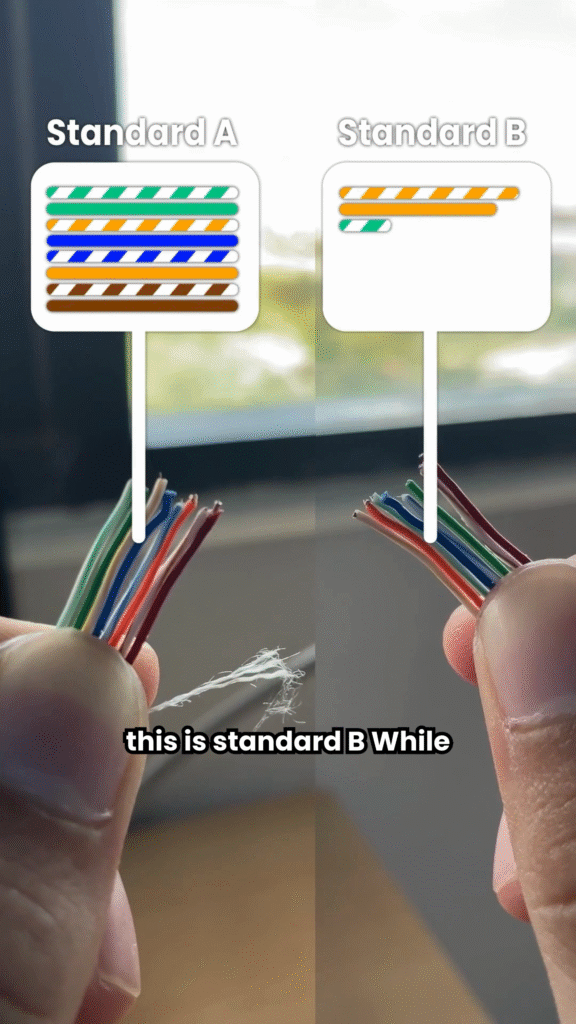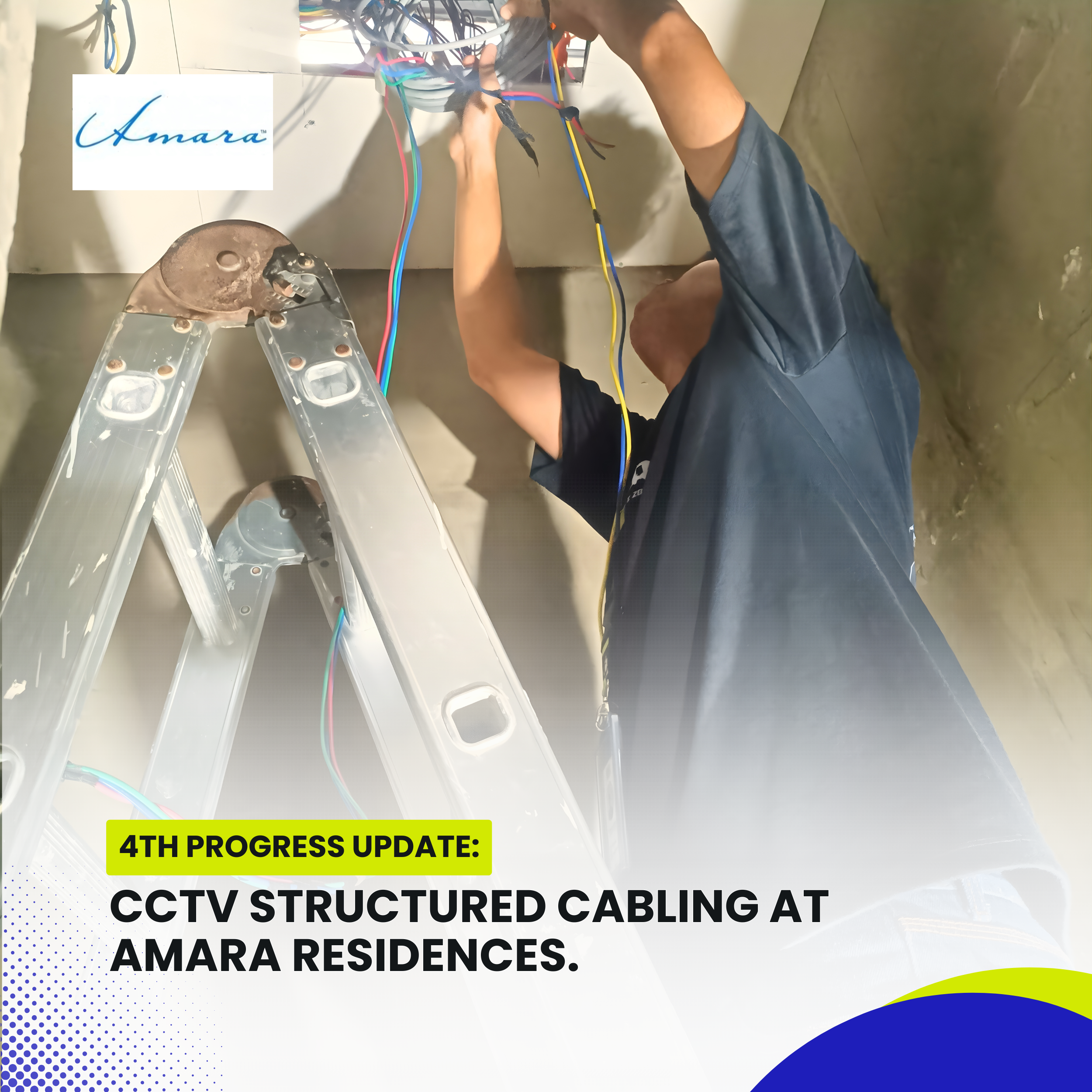AccessPoint Supply and Installation at Santo Niño Village-Final Progress Update. Introduction. Reliable wireless connectivity is essential in today’s homes, supporting daily communication, work, and entertainment needs. To ensure stable and extended network …
Termination Standards: Understanding CAT6 Type A and Type B Terminations.

Introduction
In the world of networking, the proper termination of Ethernet cables is a foundational skill that ensures network reliability, speed, and minimal signal loss. Among the various types of Ethernet cables used in structured cabling systems, Category 6 (CAT6) cables are widely adopted for their support of high-speed networks of up to 10 Gigabits per second over shorter distances. A key step in preparing CAT6 cables for use is the proper termination of their twisted pairs into connectors or patch panels using either the T568A or T568B wiring standards.
In a recent technical training video, the IT and technical team demonstrated the CAT6 cable termination process and highlighted a key preference: they chose to use the T568B wiring scheme over T568A. While both standards are functionally similar and deliver the same electrical performance, this decision raised some common questions—when should you use Type A vs. Type B, and why does it matter?
This article explores the differences between the two termination standards, the correct practices for terminating CAT6 cables, and why many professionals lean toward Type B in the field.
Video Overview.
What is CAT6 Cable?
Category 6, or CAT6, is a standardized twisted pair cable used specifically for Ethernet and other network physical layers. It supports frequencies up to 250 MHz and is backward compatible with CAT5 and CAT5e standards. CAT6 cables are commonly used in residential, commercial, and industrial environments to handle gigabit speeds and high-bandwidth applications.
Inside a CAT6 cable are four twisted pairs of copper wires, totaling eight individual conductors. Each pair is color-coded for easy identification. Termination refers to the process of attaching these wires to connectors, usually RJ45 connectors, in a specific sequence according to industry wiring standards.
T568A vs. T568B: The Two Termination Standards.
The T568A and T568B standards are defined by the Telecommunications Industry Association (TIA) and specify the order in which the wires should be arranged when terminating a cable. They apply to both CAT5e and CAT6 cables.
Here’s a breakdown of the wire color assignments for each standard:
| Pin | T568A Color | T568B Color |
|---|---|---|
| 1 | White/Green | White/Orange |
| 2 | Green | Orange |
| 3 | White/Orange | White/Green |
| 4 | Blue | Blue |
| 5 | White/Blue | White/Blue |
| 6 | Orange | Green |
| 7 | White/Brown | White/Brown |
| 8 | Brown | Brown |
As seen in the table, the only difference between the two lies in the position of the orange and green pairs. The blue and brown pairs remain the same across both standards.
Functional Equivalence but Industry Preferences.
Technically speaking, T568A and T568B are functionally the same. Both maintain proper pair sequencing to ensure signal integrity and support the same performance standards. A cable terminated with T568A on one end and T568B on the other forms a crossover cable, which was traditionally used to connect two similar devices directly, such as two computers.
However, with modern auto-sensing Ethernet devices (Auto-MDI/MDIX), the need for crossover cables has largely disappeared. Today, most Ethernet cables are wired straight-through—using the same standard on both ends.
Why Professionals Prefer T568B.
In the training video mentioned, the IT and technical team expressed a preference for T568B termination, and this is a common industry trend for several reasons:
Historical Usage in the U.S.
T568B has been the dominant standard in commercial installations in North America. Many legacy systems and patch panels were wired using this configuration, so continuing to use T568B ensures backward compatibility.Consistency in Commercial Settings
Most enterprise-level networks and data centers adhere to T568B to maintain a consistent standard across all installations. This makes future troubleshooting and expansions easier, especially when working with pre-terminated patch cords that are often T568B.Interoperability with Existing Infrastructure
Many off-the-shelf patch cables are terminated in T568B. By using the same standard for wall jacks, patch panels, and cable runs, installers reduce the risk of mismatch and connectivity issues.Team Training and Familiarity
Technicians and installers often develop muscle memory with one standard. Since T568B is more commonly used, it’s natural for teams to default to it for efficiency and consistency.
When Should You Use T568A?
Despite T568B’s dominance, there are still scenarios where T568A is appropriate or even required:
Government or Federal Contracts: Some government agencies mandate T568A as the standard, particularly when following ANSI/TIA-568-C guidelines that prioritize T568A for new installations.
Residential Cabling: T568A is sometimes preferred in residential wiring because it’s historically been aligned with the Universal Service Order Code (USOC), making it slightly more compatible with phone systems.
Project-Specific Requirements: Certain network projects may have existing infrastructure that uses T568A, in which case, continuing with A ensures uniformity.
Ultimately, it’s less about which standard is “better” and more about consistency. Mixing A and B on opposite ends of the same cable will result in a crossover configuration, which may not be desired in most structured cabling systems.
Proper CAT6 Termination Steps.
Regardless of whether you’re using T568A or B, the termination process for CAT6 follows the same general steps:
Strip the Outer Jacket
Remove about 1-2 inches of the outer jacket without nicking the internal wires. CAT6 cables often have a spline (plastic separator) to reduce crosstalk—this may need trimming if obstructive.Untwist and Align the Pairs
Carefully untwist the pairs and arrange the conductors according to the chosen standard (A or B). Keep the twists as close to the termination point as possible for signal integrity.Trim and Insert into RJ45 Connector
Flatten the wires, trim them evenly, and insert them into an RJ45 connector with the clip facing down. Double-check that each wire is in the correct position.Crimp the Connector
Use a proper crimping tool to secure the connector to the cable. A quality crimp ensures good electrical contact and mechanical strength.Test the Cable
Use a cable tester to verify pinout, continuity, and performance. Testing is essential to ensure there are no miswires or defects.
Conclusion
In structured cabling, consistency is king. Whether you choose T568A or T568B, it is critical that both ends of the cable follow the same standard to avoid creating unintended crossover cables or signal issues.
While both termination standards are valid and offer the same performance for CAT6 Ethernet, the choice between T568A and T568B usually comes down to preference, environment, and compatibility with existing infrastructure.
As seen in the video demonstration, IT and technical teams often lean toward T568B for its widespread adoption and convenience in commercial environments. However, the most important takeaway is to document your work and apply the same termination consistently across your network infrastructure.
By mastering termination standards and proper practices, technicians can ensure a reliable and high-performance network—whether in a small office or an enterprise data center.
Case Studies
CCTV Site Inspection at Guadalupe, Nichols Park subdivision. Introduction. Ensuring the reliability and performance of surveillance systems is essential in maintaining safety and security within residential communities. On this day, InstallersPH IT …
CCTV Structured Cabling at Amara Residences- 4th Progress Update.
CCTV Structured Cabling at Amara Residences- 4th Progress Update. Introduction. The fourth progress milestone of the project focuses on the installation and configuration of the network infrastructure within the client’s facility. With …

